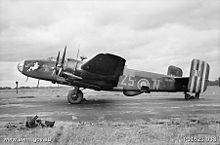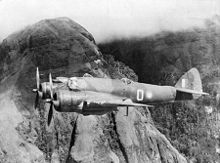
The Australian First Tactical Air Force was formed on 25 October 1944 by the Royal Australian Air Force (RAAF). Its purpose was to provide a mobile force of fighter and ground attack aircraft that could support Allied army and naval units fighting the Empire of Japan in the South West Pacific Area. One of several Allied tactical air forces formed during World War II, it evolved from the RAAF's No. 10 Operational Group, established a year earlier. Following action in the assaults on Aitape and Noemfoor, the group was renamed the First Tactical Air Force to better reflect its size and role. It was beset with morale and leadership issues in early 1945, but recovered to take part in the battles of Tarakan, North Borneo, and Balikpapan. Reaching its peak strength of over 25,000 personnel in July 1945, No. 1 TAF's squadrons operated such aircraft as the P-40 Kittyhawk, Supermarine Spitfire, Bristol Beaufighter, and B-24 Liberator. The formation remained active following the end of hostilities in the Pacific until it was disbanded on 24 July 1946.

No. 12 Squadron was a Royal Australian Air Force (RAAF) general purpose, bomber and transport squadron. The squadron was formed in 1939 and saw combat in the South West Pacific theatre of World War II. From 1941 to 1943, it mainly conducted maritime patrols off northern Australia. The squadron was based at Merauke in western New Guinea from November 1943 to July 1944, when it was withdrawn from operations. After being re-equipped, it operated as a heavy bomber unit from February 1945 until the end of the war. The squadron continued in this role until it was redesignated No. 1 Squadron RAAF in February 1948. The squadron was reformed in 1973 to operate transport helicopters but was again disbanded in 1989.

No. 81 Wing is responsible for operating the Lockheed Martin F-35 Lightning II multi-role fighters of the Royal Australian Air Force (RAAF). Headquartered at RAAF Base Williamtown, New South Wales, the wing comprises three combat units, Nos. 3 and 77 Squadrons based at Williamtown and No. 75 Squadron at RAAF Base Tindal, Northern Territory, as well as an operational conversion unit at Williamtown. No. 81 Wing headquarters oversees squadron training in air-to-air and air-to-ground tactics, and support for the Australian Army and Royal Australian Navy. Tasked with offensive and defensive counter-air operations, the Hornets have been deployed to Diego Garcia in 2001–02, when they provided local air defence, to Iraq in 2003, when they saw action flying fighter escort and close air support missions in concert with Coalition forces, and to the Middle East in 2015–16, when they undertook strike operations during the military intervention against ISIL. They have also been employed to patrol high-profile events in Australia, including the Commonwealth Games and visits by foreign dignitaries.

Central Flying School (CFS) is a Royal Australian Air Force (RAAF) training unit, located at RAAF Base East Sale, Victoria. It operates the Pilatus PC-21 turboprop trainer. The school is responsible for training flight instructors, setting flying standards, and auditing flying practices. It is also home to the "Roulettes" aerobatic team. CFS was the first military aviation unit to be formed in Australia, in 1913, when its role was to provide basic flying training. Its current form dates from World War II, when it was re-established to train flying instructors for the Empire Air Training Scheme (EATS).

North-Eastern Area Command was one of several geographically based commands raised by the Royal Australian Air Force (RAAF) during World War II. For most of its existence it controlled units based in central and northern Queensland as well as Papua New Guinea. It was formed in January 1942 from the eastern part of the former Northern Area Command, which had covered all of northern Australia and Papua. Headquartered at Townsville, Queensland, North-Eastern Area Command's responsibilities included air defence, aerial reconnaissance and protection of the sea lanes within its territory. Its flying units, equipped with fighters, reconnaissance bombers, dive bombers and transports, took part in the battles of Rabaul, Port Moresby and Milne Bay in 1942, and the landings at Hollandia and Aitape in 1944.

No. 78 Squadron was a Royal Australian Air Force (RAAF) fighter squadron of World War II. It was formed in July 1943 as part of expansion of the RAAF's fighter force, and was assigned to mobile striking forces for the duration of the war.

No. 80 Squadron was a Royal Australian Air Force (RAAF) fighter squadron that operated during World War II. The squadron was formed in September 1943 and was disbanded in July 1946 after seeing action in the South West Pacific Theatre of the war.

No. 86 Squadron was a Royal Australian Air Force (RAAF) fighter squadron of World War II. The squadron was formed in March 1943 and was deployed to Merauke in Dutch New Guinea in July that year. While No. 86 Squadron was stationed at Merauke until April 1944, it saw little combat. After being transferred back to Australia its aircraft and personnel were transferred to other units, and only a nucleus of the squadron remained. While it was re-equipped with new aircraft in June 1945, the war ended before the squadron was ready for combat and it was disbanded in December 1945.
No. 1 Wing was an Australian Flying Corps (AFC) and Royal Australian Air Force (RAAF) wing active during World War I and World War II. The wing was established on 1 September 1917 as the 1st Training Wing and commanded the AFC's pilot training squadrons in England until April 1919, when it was disbanded. It was reformed on 7 October 1942 as a fighter unit comprising two Australian and one British flying squadrons equipped with Supermarine Spitfire aircraft, and a mobile fighter sector headquarters. The wing provided air defence to Darwin and several other key Allied bases in northern Australia until the end of the war, and was again disbanded in October 1945.

No. 80 Wing was a Royal Australian Air Force (RAAF) wing of World War II. The unit was formed on 15 May 1944 and eventually comprised three squadrons equipped with Spitfire fighter aircraft. The wing's headquarters was absorbed into the newly formed No. 11 Group on 30 July 1945.

No. 73 Wing was a Royal Australian Air Force (RAAF) wing of World War II. It was formed in February 1943 at Port Moresby, Papua New Guinea, as part of No. 9 Operational Group. The wing initially comprised three attack squadrons flying CAC Wirraways, Douglas Bostons, and Bristol Beaufighters, with which it took part in the New Guinea campaign until mid-year. It was then reorganised with three fighter squadrons operating P-40 Kittyhawks and Supermarine Spitfires; in this form it saw action in the New Britain and Admiralty Islands campaigns through 1943–44. The wing was disbanded at Los Negros in August 1944, and by the beginning of 1945 its squadrons had been absorbed into other RAAF wings under No. 10 Operational Group.

No. 79 Wing was a Royal Australian Air Force (RAAF) wing of World War II. It was formed in December 1943 at Batchelor, Northern Territory, as part of North-Western Area Command. Led by Group Captain Charles Eaton, the wing comprised four squadrons on its establishment, flying Beaufort and B-25 Mitchell bombers and Beaufighter heavy fighters. No. 79 Wing took part in the New Guinea and North-Western Area Campaigns during 1944–45, eventually transferring to Balikpapan in the Dutch East Indies as the Allies advanced northward. By the end of the Pacific War, the wing was attached to the Australian First Tactical Air Force and was made up of Nos. 2 and 18 Squadrons, both flying Mitchells. The latter transferred to the Netherlands Air Force in late 1945, while the former returned to Australia where it disbanded the following year. No. 79 Headquarters itself disbanded in October 1945, soon after the end of hostilities.

Air Vice Marshal Ian Dougald McLachlan, CB, CBE, DFC was a senior commander in the Royal Australian Air Force (RAAF). Born in Melbourne, he was a cadet at the Royal Military College, Duntroon, before joining the Air Force in December 1930. After serving in instructional and general flying roles, he took command of No. 3 Squadron in December 1939, leading it into action in the Middle East less than a year later. Awarded the Distinguished Flying Cross, he returned to Australia in 1942 to command air bases in Canberra and Melbourne. The following year he was posted to the South West Pacific, where he led successively Nos. 71 and 73 Wings. Having been promoted to group captain, he took charge of Southern Area Command in 1944, and No. 81 Wing in the Dutch East Indies the following year.
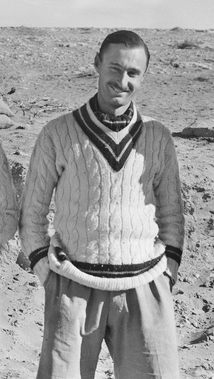
Air Commodore Gordon Henry Steege, DSO, DFC was a senior officer in the Royal Australian Air Force (RAAF). He became a fighter ace in World War II, credited with eight aerial victories. Joining the RAAF in July 1937, Steege first saw action with No. 3 Squadron in the Middle East, where he was awarded the Distinguished Flying Cross after shooting down three German aircraft in a single sortie. He rose to command No. 450 Squadron in the Desert Air Force, before being posted to the South West Pacific, where he led Nos. 73 and 81 Wings. He earned the Distinguished Service Order for his "outstanding leadership", and finished the war a temporary group captain.

No. 72 Wing was a Royal Australian Air Force (RAAF) wing that operated during World War II. It was formed in April 1943 at Townsville, Queensland, as part of North-Eastern Area Command. Led by Group Captain Charles Eaton, the wing soon deployed to Merauke, Dutch New Guinea, where it comprised three squadrons flying CAC Boomerang and P-40 Kittyhawk fighters, and A-31 Vengeance dive bombers. Eaton was succeeded by Group Captain Allan Walters in mid-1943. No. 72 Wing took part in the defence of Torres Strait, undertaking interception, patrol and occasional ground-attack and anti-shipping duties. By July 1944, its original squadrons had all been disbanded or transferred to other operational formations. No. 120 Squadron, which had arrived in May 1944, operating Kittyhawks, remained at Merauke until February 1945. The wing headquarters returned to Australia that May, and disbanded the following month.
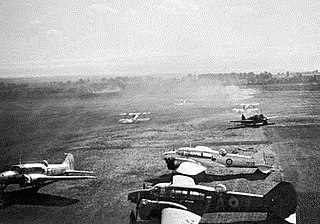
No. 2 Service Flying Training School was a flying training school of the Royal Australian Air Force (RAAF) that operated during World War II. It was formed in July 1940, under the command of Wing Commander Frederick Scherger. Responsible for intermediate and advanced instruction of pilots under the Empire Air Training Scheme (EATS), the school was based at RAAF Station Forest Hill near Wagga Wagga, New South Wales, and operated CAC Wirraway and Avro Anson aircraft. The Ansons were phased out in July 1941, and the school became an all-Wirraway unit. In 1942 the RAAF divided the personnel and equipment of No. 2 SFTS between Nos. 5 and 7 Service Flying Training Schools at Uranquinty and Deniliquin, respectively. No. 2 SFTS was disbanded that April, and the base facilities taken over by No. 5 Aircraft Depot.

Western Area Command was one of several geographically based commands raised by the Royal Australian Air Force (RAAF) during World War II. It was formed in January 1941, and controlled RAAF units located in Western Australia. Headquartered in Perth, Western Area Command was responsible for air defence, aerial reconnaissance and protection of the sea lanes within its boundaries. Its aircraft conducted anti-submarine operations throughout the war, and attacked targets in the Dutch East Indies during the Borneo campaign in 1945.

North-Western Area Command was one of several geographically based commands raised by the Royal Australian Air Force (RAAF) during World War II. Its wartime sphere of operations included the Northern Territory, adjacent portions of Queensland and Western Australia, and the Dutch East Indies. The command was formed in January 1942, following the outbreak of the Pacific War, from the western part of Northern Area Command, which had covered all of northern Australia and Papua. Headquartered at Darwin, North-Western Area Command was initially responsible for air defence, aerial reconnaissance and protection of the sea lanes within its boundaries.

Richard Cresswell, DFC was an officer and pilot in the Royal Australian Air Force (RAAF). He held command of No. 77 (Fighter) Squadron twice during World War II, and again during the Korean War. Cresswell was credited with being the first RAAF pilot to shoot down an enemy aircraft at night over Australian soil, the only man to serve as commanding officer of an RAAF squadron on three occasions during wartime, and the first officer to lead a jet-equipped Australian squadron in combat. His performance in Korea earned him both the Commonwealth and the US Distinguished Flying Crosses.
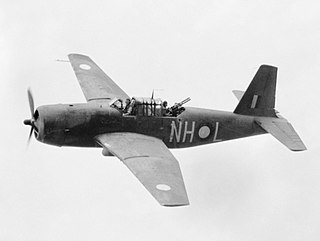
The Royal Australian Air Force (RAAF) operated Vultee Vengeance dive bombers during World War II. The Australian Government ordered 297 of the type in late 1941 as part of efforts to expand the RAAF. This order was later increased to 400 aircraft. A few Vengeances arrived in Australia during 1942, and large-scale deliveries commenced in early 1943; further orders were cancelled in 1944 after 342 had been delivered.


